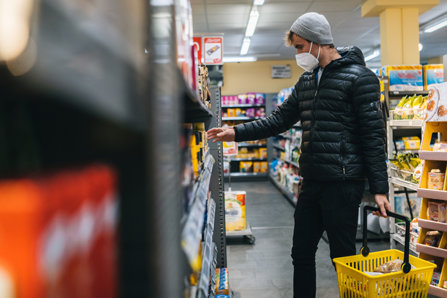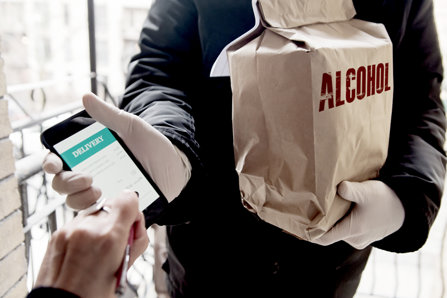Liquor Store Sales Soar During Pandemic

While the pandemic certainly brought with it a host of serious problems for the American people, one of the worst side effects of the health crisis may have been the pushing of many Americans who were already struggling with substance abuse into an even worse condition, a condition where they now regularly misuse alcohol to extreme levels of consumption.
A new study found that Americans engaged in more instances of at-home alcohol consumption during the COVID-19 pandemic than in the months before the pandemic began. And while restaurant and bar-related alcohol sales did fall considerably (by about 15%) during the pandemic, liquor store sales soared, more than canceling out the drop in restaurant/bar sales. And with supporting data from the National Institute on Alcohol Abuse and Alcoholism on increased alcohol-related deaths in 2020, there is reason to believe that more Americans are struggling with alcohol misuse now than perhaps ever before.
The pandemic may have been temporary. Alcohol addiction, unless treated with a qualified rehabilitation program, won’t be. That’s why Americans must come together now and help their loved ones who are addicted to alcohol get help at qualified treatment centers, before it’s too late.
Liquor Store Sales and At-Home Drinking; a Different Kind of Alcohol Addiction

When people think of alcohol abuse, the typical image that comes to mind is someone drinking far too much alcohol at a bar, club, restaurant, sports game, public venue, party, or other social event. But alcohol consumption never even has to leave the secrecy and privacy of one’s own home for it to be dangerous. The pandemic showed this to be true, all too painfully.
Recent research published in the journal Alcohol found that sales at liquor stores soared during the pandemic, with the logical conclusion being that many Americans who could no longer go to bars, restaurants, parties, clubs, and other social events were consuming alcohol at home instead. During the COVID-19 pandemic periods of March 2020 to September 2020, the researchers found that $41.9 billion was spent at liquor stores, an increase of 20% compared to the same period in the previous year, pre-pandemic.
Evidence of an increase in at-home alcohol abuse during 2020 also came forward in the form of increased alcohol-related deaths that year. The National Institute on Alcohol Abuse and Alcoholism recently modified its statistical findings for annual alcohol-related deaths. In 2020, when most Americans who struggle with alcohol misuse were doing their drinking at home, alcohol-related deaths went up, not down. Before 2020, about 88,000 Americans were dying from alcohol-related causes each year. But the NIAAA recently revised its reporting on alcohol-related deaths. According to current data, about 95,000 Americans died from alcohol-related causes in 2020, even though alcohol consumption at bars, restaurants, clubs, parties, sports games and other public events dropped dramatically.
Alcohol Misuse Harms Immune Response, Placing Addicts in Further Risk During a Pandemic
There was also a dual crisis occurring here, in the form of alcohol abuse being directly harmful to one’s immune system, making them more likely to contract viral infections while under the influence of alcohol. Quoting one report by the NIAAA, “Drinking too much can weaken your immune system, making your body a much easier target for disease. People who drink chronically are more liable to contract diseases like pneumonia and tuberculosis than people who do not drink too much. Drinking a lot on a single occasion slows your body’s ability to ward off infections – even up to 24 hours after getting drunk.” As one can imagine, this crucial factor put alcohol addicts even more at risk during 2020.
Alcohol Delivery Services; Making a Bad Problem Worse

Yet another factor exacerbated the problem of alcohol abuse at home in 2020. It became easier than perhaps ever before to misuse alcohol at home thanks to alcohol delivery services. Despite increased rates of alcohol misuse, harm to immune response, and rising death rates, Americans capitalized on the option to have alcohol delivered to their front door.
Amid America’s worst pandemic since the 1918 Spanish Influenza, online businesses like Drizly and Saucey cropped up with the singular purpose of assisting Americans in consuming alcohol at home. Once alcohol delivery became more frequent and accepted (which did not take long), major food delivery services like DoorDash, Uber Eats, Grubhub, and Instacart joined in.
Sadly, there is a direct relationship between increasing usage of alcohol delivery services and alcohol misuse. There is little information on this in the U.S., but researchers in New Zealand found that people who purchased alcohol during the pandemic via delivery services had a 75% higher chance of drinking to excess than those who purchased alcohol in-person at supermarkets.
There’s much to be said about the dangers of excessive alcohol consumption at home. People who drink to excess at home may start drinking earlier in the day. They may be less likely to stop drinking after a certain number of drinks, as they do not have to drive anywhere after they’re done drinking. They might be inclined to drink more, as no one is there to pass judgment on them. They’re also more likely to experience alcohol-related illnesses and have no one nearby to help them. Combine those factors with the social isolation of being at home and alone, and it’s a grim picture, a harsh condition that puts the drinker at great risk.
Alcohol Abuse at Home; A Serious Issue Demanding Attention and Treatment
Looking back on the last year and a half, many factors have combined to make alcohol addiction an even more pervasive, serious, and deadly problem than it was before. A pandemic, plus increased drinking at home, exacerbated by physical harm resulting from drinking to excess, further exacerbated by it now being easier to drink at home via alcohol online ordering and delivery services, all combine to create a serious alcohol addiction epidemic.
Even given all of those factors, it would be advised not to draw a direct, causal relationship between the COVID-19 pandemic and an increase in the number of Americans addicted to alcohol. It’s not that the pandemic “made people into alcohol addicts” so much as the pandemic created a harsh situation in which people who were already struggling began struggling even more.
What the pandemic did make clear is that life can be suddenly upended at a moment’s notice, and an already difficult struggle with substance abuse can be made much, much worse, practically overnight. This fact should remind us that we must help our family members when we know something is not going well with them. If someone we care about is struggling with an addiction to alcohol, we need to get them help before it is too late.
If you know someone who is struggling with alcohol addiction, please make sure they get help at a treatment center. Don’t take no for an answer, and don't stop trying to help them until they agree to seek treatment.
Sources:
- https://doi.org/10.1016/j.alcohol.2021.06.004
- https://www.niaaa.nih.gov/publications/brochures-and-fact-sheets/alcohol-facts-and-statistics
- https://www.niaaa.nih.gov/alcohols-effects-health/alcohols-effects-body
- https://pubmed.ncbi.nlm.nih.gov/33283442/


